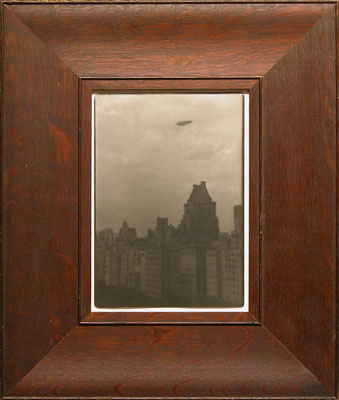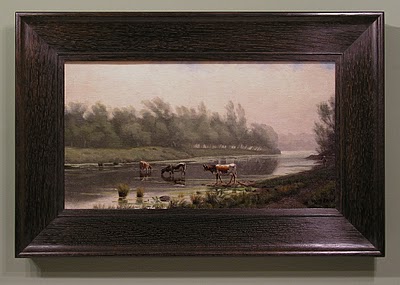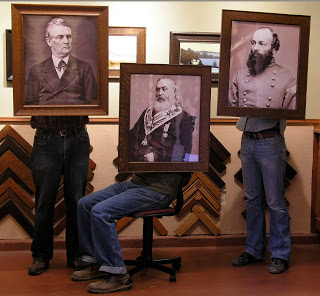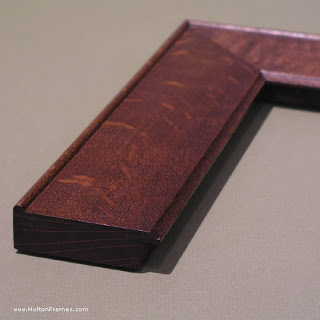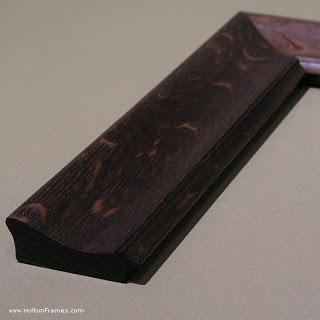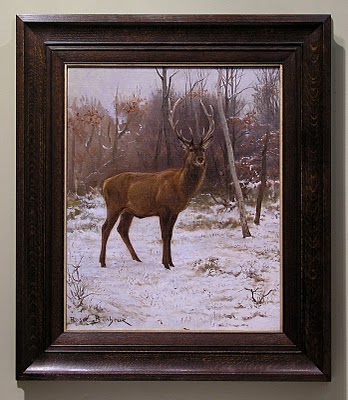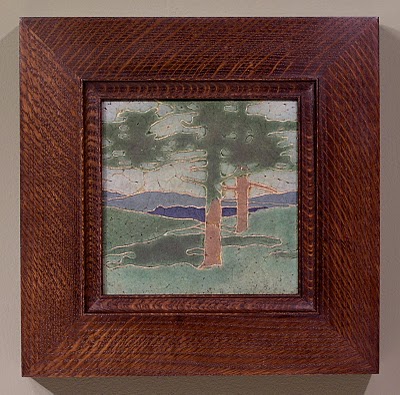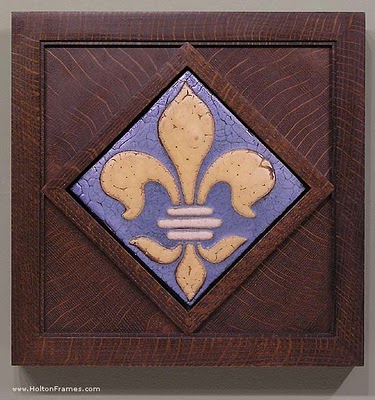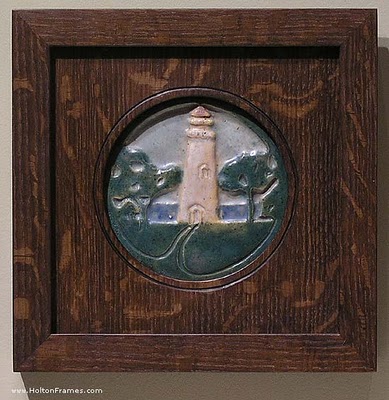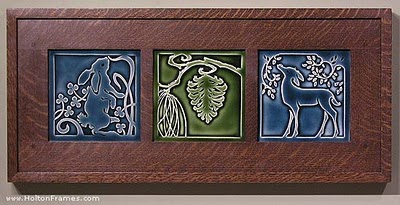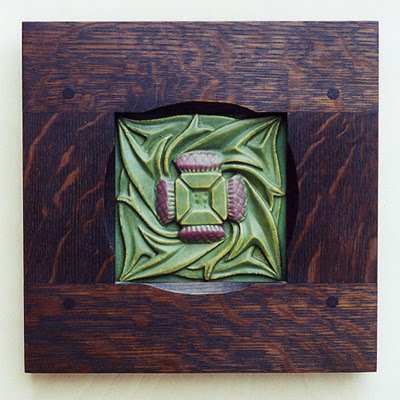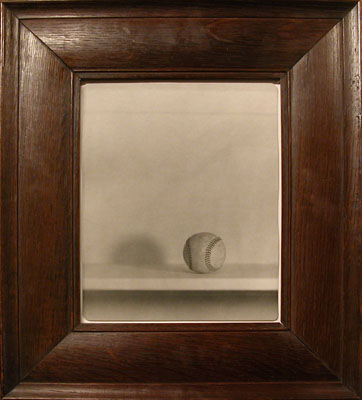We’ve had the privilege of framing more and more historical work, and this past month got to re-frame this sweet oil painting, “Foggy Morning,” (10″ x 17″) by Ludmilla Welch, who with her husband Thaddeus Welch, worked in San Francisco at the turn of the century. It’s in a very low slope No. 248—3″ wide profile in stained quartersawn white oak.
Archives
True Grit: See us on the big screen!
From Gold to Oak—I: Re-Framing Rosa Bonheur Stags
The theme of this post, replacing gilt frames with dark wood frames, has since been greatly expanded upon on a page created a couple years later, “Fixing ‘A Very Prevalent Error: The Cabinetmaker’s Answer to the Gold Frame Convention,” here.
 Have you ever looked at a painting and realized that you were fighting to see past the frame, that the frame was actually inhibiting you from seeing the painting? Maybe you’ve held your hands up to one eye and used them to block out the frame. That was very much my reaction—and I suspect the reaction of the customer who brought it to me—when I first laid eyes on this sweet little oil by the great French painter Rosa Bonheur. The elaborate, swirly gold frame was so imperious, showy and unsympathetic to everything about the picture—the subject, palette, line work, forms and, above all, the rustic spirit—that it actually felt laborious to really study and appreciate the painting itself. (The owner was also seeking a frame that would be more suitable to the painting’s destination in a log home.) At just a little over 8″ x 6″, it was being eaten alive by some past owner’s or dealer’s insecurities (it didn’t help that a makeshift gold colored liner had been used to make the painting fit a 10″ x 8″ frame). The poor creature appears inexplicably displaced to some Parisian bank manager’s parlor, and seems to stare at us as if to say, “What the heck am I doing here?”
Have you ever looked at a painting and realized that you were fighting to see past the frame, that the frame was actually inhibiting you from seeing the painting? Maybe you’ve held your hands up to one eye and used them to block out the frame. That was very much my reaction—and I suspect the reaction of the customer who brought it to me—when I first laid eyes on this sweet little oil by the great French painter Rosa Bonheur. The elaborate, swirly gold frame was so imperious, showy and unsympathetic to everything about the picture—the subject, palette, line work, forms and, above all, the rustic spirit—that it actually felt laborious to really study and appreciate the painting itself. (The owner was also seeking a frame that would be more suitable to the painting’s destination in a log home.) At just a little over 8″ x 6″, it was being eaten alive by some past owner’s or dealer’s insecurities (it didn’t help that a makeshift gold colored liner had been used to make the painting fit a 10″ x 8″ frame). The poor creature appears inexplicably displaced to some Parisian bank manager’s parlor, and seems to stare at us as if to say, “What the heck am I doing here?”
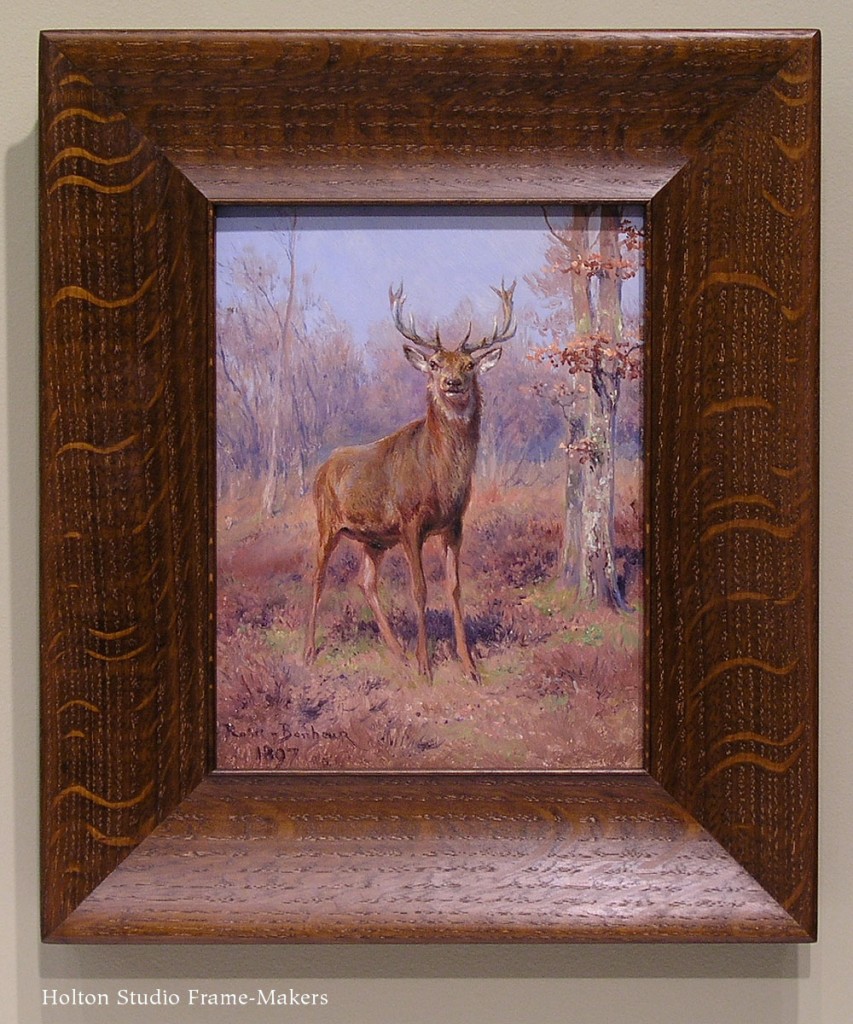 Relief finally came when I removed the work from its setting and could enjoy this stately fellow whom Mademoiselle Bonheur had distinguished so skillfully. Seeing past the significance of the painting and refusing to be awed by the signature in order to appreciate the work itself, I could craft no better solution than this plain and simple 2-5/8″ wide flattened scoop with a single bead at the sight edge. At last, we can see the painting without effort, and the stag is in his natural habitat, warily watching us as intruders of his home.
Relief finally came when I removed the work from its setting and could enjoy this stately fellow whom Mademoiselle Bonheur had distinguished so skillfully. Seeing past the significance of the painting and refusing to be awed by the signature in order to appreciate the work itself, I could craft no better solution than this plain and simple 2-5/8″ wide flattened scoop with a single bead at the sight edge. At last, we can see the painting without effort, and the stag is in his natural habitat, warily watching us as intruders of his home.
A larger Bonheur of similar subject matter came in about a year later, with a similarly overbearing frame. Damaged in transit, the composition—or “compo”—breaking off demonstrates the dubious
service of frames like this as protectors of paintings, not to mention the debased character of compo as fake carving. At 22″ x 18″, this canvas called for a larger and stronger frame, although with the same approach to line and form which we’d taken with framing the earlier painting.
The suitably rustic spirit of the quartersawn white oak frame molded to harmonize in line and form with this quiet but accomplished work, a dark stain to lead the eye to the lighter painting (the eye goes to light; frames are generally more successful when they’re darker than the picture), and a touch of pale gold leaf on oak at the sight edge to echo the painting’s contrasts and lend a note of honor to this noble beast all contribute to a setting that sustains and expands the spirit of this fine work and allows us at last to see and admire the painting.
Framing Arts and Crafts Tiles
Suitable frames for tiles are hard to come by—especially as the old tiles in particular become more highly treasured: folks want to do them proud, but production frames on small works of real handcraft only accentuate their makeshift nature. Yes, tile frames are easy to overdo, and there’s absolutely nothing wrong with a totally plain frame. But tiles are highly architectural, which makes them similar to paintings in being able to hold up to substantial frames. Having relief helps them in this respect as well. I want to show a few examples of what can be done with an exceptional tile that you might want to feature in your home with a frame that both protects and suitably honors it. It’s also an opportunity to demonstrate what a single key design element can do for any piece of art.
This first piece, above, is a Grueby tile—a great and iconic Arts and Crafts piece familiar to many. At just 6″ x 6″ it wanted a restrained treatment. The fine line work suggested the two fine beads for the sight edge of the frame, while the cove (between the beads) provided a gentle means of focusing the eye on and taking the viewer in to the quiet mood of the piece.
The second example is another Grueby piece—an insignia tile in a diagonal format which offered an enjoyable challenge. We focused on the format of the of the piece to suggest an interesting design. This is two mitered frames with floating panels in the triangular spaces. I had fun using the ray flake to create kind of a sunburst effect.
The third example is a round trivet tile with a scene rendered in carved lines. Trevor expertly carved a line of the same size and shape (a small flute) just outside the circular window.
The series here is contemporary, made by Carreux de Nord out of Wisconsin. The wonderful line work in these needed only a complementary rectilinear treatment of the frame. A mortise-and-tenon flat was used for its architectural character and to enhance the horizontal format of the tiles. This frame in particular could be hung to achieve great mural feeling. A mitered cap molding was chosen to contain and delineate the whole composition. What beautiful work these tile makers do!
Finally, another mortise-and-tenon frame we made years ago for a Rookwood Thistle tile. Again, the frame couldn’t be simpler, except for the chamfer that amplifies the lines of the tile.
Of course, in all these examples, beautifully flaked quartersawn oak provides a great deal of interest as well as suitable material for Arts and Crafts items and the homes they’re likely to reside in.
All these frames are flat, in keeping with the decorative flat treatment of the tiles, relying on just one element in the frame to echo a key element in the tile. But that’s enough to achieve the frame’s goal of sustaining and expanding the spirit of an artwork into the architectural realm and the life of the setting in which it will take its place.
Wedding Gifts
With wedding season approaching I thought I’d put out a couple of examples of pieces we’ve recently done as wedding gifts. This picture’s framed close in a simple walnut “Hudson” frame with a gilt slip. Walnut, which is a tight-grained wood, has a smooth finish which suits the finish of the photo. The form gives a picture some space but has a graceful shape that su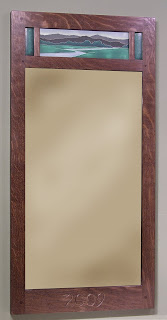 its the figurative subject matter. I think we struck the right balance between the formality of the image and occasion and the informality of the rustic porch (it’s actually a kind of stage set at the Museum of the New South in Charlotte, NC).
its the figurative subject matter. I think we struck the right balance between the formality of the image and occasion and the informality of the rustic porch (it’s actually a kind of stage set at the Museum of the New South in Charlotte, NC).
The second example is a mirror made for a customer who found an image in tile that she liked as an appropriate image for newlyweds, and wanted it integrated into a mirror to give as a wedding gift. (Mirrors make great wedding gifts, because when you get married you have to watch yourself.) I also carved the year of the wedding, 2009, into the bottom. The tiles are by Motawi Tileworks (the two on either side of the landscape tile are actually glaze samples). Made in quartersawn white oak (Weathered Oak stain) it measures about 38″ x 18-1/2″.
Jefferson Hayman
A couple of weeks ago an artist and customer, Mallory Lake (more on her another day) forwarded me a link to the website of Jefferson Hayman (www.jeffersonhayman.com), a New York photographer with an exceptional interest in picture frames. We had a nice chat on the phone. Turns out he used to be the director of Eli Wilner and Co. Jefferson and I share a fondness for the old oak frames. (More on those in my article in the current Style:1900.) Peruse Jefferson’s site.